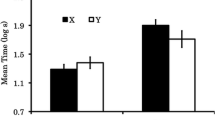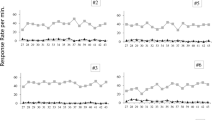Abstract
Previous research has demonstrated that rats can use unsignaled shock to predict subsequent periods free from shock. This shock-no shock stimulus arrangement, termed an autocontingency, has appeared less likely to exert behavioral control when a traditional tone-shock contingency was simultaneously available. The present research examined the generality of CS-US contingency dominance in a conditioned suppression paradigm by using a summation test in which “probe” stimuli derived from tone-shock contingencies were superimposed upon responding maintained by an autocontingency. In experiment 1, an inhibitory CS accelerated responding only when responding was normally suppressed by the autocontingency. In experiment 2, an excitatory CS failed to yield conditioned suppression during an inhibitory (accelerative) period produced by the autocontingency. Unlike our previous findings (e.g., Davis, Memmott & Hurwitz, 1975), these results do not support a general notion of tone-shock contingency dominance over autocontingencies. Behavioral control by autocontingencies appears robust and “holds its own” in summation with both excitatory and inhibitory CSs derived from traditional contingencies.
Similar content being viewed by others
References
Azrin, N. H.: Some effects of two intermittent schedules of immediate and non-immediate punishment. J. Psychol.42, 3–21, 1956.
Brimer, C. J.: Disinhibition of an operant response. Learn. Motivation1, 346–371, 1970.
Davis, H.: Conditioned suppression: A survey of the literature. Psychonom. Monogr. Suppl.2, 283–291, 1968.
Davis, H., Herrmann, T., MacFadden, L. and Ellen, P.: Do septal lesions eliminate behavioral control by an autocontingency? Physiol. Psychol.5, 339–342, 1977.
Davis, H. and MacFadden, L.: Is autocontingency control established when a traditional contingency is simultaneously available? Bull. Psychonom. Soc.11, 387–389, 1978.
Davis, H. and McIntire, R.: Conditioned suppression under positive, negative, and no contingency between conditioned and unconditioned stimuli. J. Exp. Anal. Behav.12, 663–640, 1969.
Davis, H., Memmott, J. and Hurwitz, H. M. B.: Autocontingencies: A model for subtle behavioral control. J. Exp. Psychol. General104, 169–188, 1975.
Davis, H., Memmott, J. and Hurwitz, H. M. B.: Effects of signals preceding and following shock on baseline responding during a conditioned suppression procedure. J. Exp. Anal. Behav.25, 263–277, 1976.
Davis, H. and Shattuck, D.: Autocontingencies: Effects of unsignaled shock during a progressively degraded conditioned suppression procedure. Paper read at Psychonomic Society, 1978, San Antonio, Texas.
Davis, H. and Wright, J.: Procedural and parametric variability in studies of conditioned suppression. Bull. Psychonom. Soc.14, 149–150, 1979.
Estes, W. K. and Skinner, B. F.: Some quantitative properties of anxiety. J. Exp. Psychol.29, 390–400, 1941.
Hammond, L.: Increased responding to CS-in differential CER. Psychonom. Sci.5, 337–338, 1966.
Hearst, E.: Some persistent problems in the analyses of conditioned inhibition.In Boakes, R. and Halliday, M. (eds.),Inhibition and Learning. New York, Academic Press, 1972, pp. 5–39.
Lyon, D. O.: Conditioned suppression: operant variables and aversive control. Psychol. Rec.18, 317–338, 1968.
Pavlov, I. P.:Conditioned reflexes. Translated by G. V. Anrep. London, Oxford University Press, 1927.
Reberg, D.: Compound tests for excitation in early acquisition and after prolonged extinction of conditioned suppression. Learn. Motivation3, 246–258, 1972.
Rescorla, R. A.: Pavlovian conditioning and its proper control procedures. Psychol. Rev.74, 71–80, 1967.
Rescorla, R. A.: Pavlovian conditioned inhibition. Psychol. Bull.72, 77–94, 1969.
Rescorla, R. A. and Solomon, R.: Two process learning theory: Relationships between Pavlovian conditioning and instrumental learning. Psychol. Rev.74, 151–182, 1967.
Seligman, M. E. P. and Meyer, B.: Chronic fear and ulceration in rats as a function of unpredictability of safety. J. Comp. Physiol. Psychol.73, 202–207, 1970.
Author information
Authors and Affiliations
Additional information
Supported in part by Grant No. A0673 from the National Research Council of Canada.
Rights and permissions
About this article
Cite this article
Davis, H., Herrmann, T. & Shattuck, D. Summation of excitatory and inhibitory control produced by traditional tone-shock contingencies and autocontingencies. Pav. J. Biol. Sci. 14, 254–262 (1979). https://doi.org/10.1007/BF03003008
Issue Date:
DOI: https://doi.org/10.1007/BF03003008




